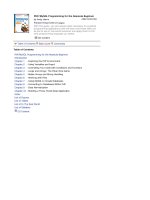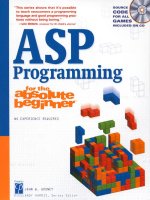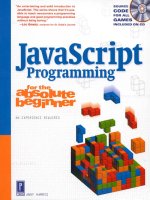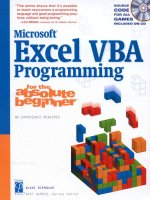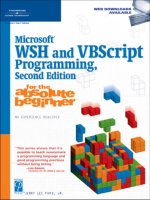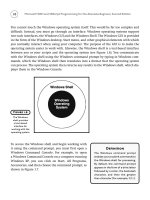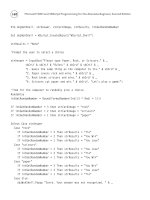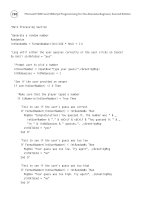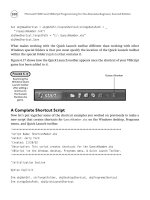C Programming for the Absolute Beginner phần 4 pot
Bạn đang xem bản rút gọn của tài liệu. Xem và tải ngay bản đầy đủ của tài liệu tại đây (14.99 MB, 28 trang )
in flowcharts by looking at the program flow. If you see connector lines that loop back to the
beginning of a condition (diamond symbol), you know that the condition represents a loop.
In this example, the program flow moves in a circular pattern. If the condition is
true,
employee payroll is processed and program control moves back to the beginning of the orig-
inal condition. Only if the condition is
false does the program flow terminate.
Take a look at the next set of pseudo code, which is implemented as a flowchart in Figure 4.2.
while end-of-file == false
if pay-type == salary then
pay = salary
else
pay = hours * rate
end If
loop
FIGURE 4.2
Flowchart
demonstrating a
looping structure
with inner
condition.
In Figure 4.2, you see that the first diamond symbol is really a loop’s condition because pro-
gram flow loops back to its beginning. Inside of the loop, however, is another diamond, which
is not a loop. (The inner diamond does not contain program control that loops back to its
origin.) Rather, the inner diamond’s program flow moves back to the loop’s condition regard-
less of its outcome.
85
Chapter 4 • Looping Structures
Let’s take another look at a previous pseudo code example (the flowchart is shown in
Figure 4.3), which moves the condition to the end of the loop.
do
display menu
while user-selection != quit
FIGURE 4.3
Moving a loop’s
condition to the
end of the loop.
Remember: The program flow holds the key. Because the loop’s condition in Figure 4.3 is at
the end of the loop, the first process in the flowchart is displaying the menu. After displaying
the menu, the loop’s condition is encountered and evaluated. If the loop’s condition is
true,
the program flow loops back to the first process; if
false, the program flow terminates.
The final component to building looping algorithms with flowcharts is demonstrating nested
loops. Take another look at the nested loop pseudo code from the previous section.
do
display menu
If user-selection == payroll then
while end-of-file != true
if pay-type == salary then
pay = salary
else
86
C Programming for the Absolute Beginner, Second Edition
pay = hours * rate
end If
loop
end if
while user-selection != quit
Figure 4.4 implements the preceding looping algorithm with flowcharting symbols and
techniques.
FIGURE 4.4
Using a flowchart
to demonstrate
nested loops.
Although Figure 4.4 is much more difficult to follow than the previous flowchart examples,
you should still be able to identify the outer and inner (nested) loops by finding the diamonds
that have program flow looping back their condition. Out of the four diamonds in Figure 4.4,
87
Chapter 4 • Looping Structures
can you find the two that are loops? Again, to determine which diamond symbol represents
a loop, simply identify each diamond that has program control returning to the top part of
the diamond.
Here are the two loops in Figure 4.4 represented in pseudo code:
•
while user-selection != quit
O
PERATORS
C
ONTINUED
You’ve already learned how to assign data to variables using the assignment operator (equal
sign). In this section, I’ll discuss operators for incrementing and decrementing number-based
variables, and I’ll introduce new operators for assigning data to variables.
++ Operator
The ++ operator is useful for incrementing number-based variables by 1. To use the ++ operator,
simply put it next to a variable, as shown next.
iNumberOfPlayers++;
To demonstrate further, study the following block of code, which uses the ++ operator to
produce the output shown in Figure 4.5.
#include <stdio.h>
main()
{
int x = 0;
printf("\nThe value of x is %d\n", x);
x++;
printf("\nThe value of x is %d\n", x);
}
FIGURE 4.5
Incrementing
number-based
variables by 1 with
the ++ operator.
88
C Programming for the Absolute Beginner, Second Edition
• while end-of-file != false
The increment operator (++) can be used in two ways: As demonstrated earlier, you can place
the increment operator to the right of a variable, as shown next.
x++;
This expression tells C to use the current value of variable x and increment it by 1. The vari-
able’s original value was 0 (that’s what I initialized it to) and 1 was added to 0, which resulted
in 1.
The other way to use the increment operator is to place it in front or to the left of your variable,
as demonstrated next.
++x;
Changing the increment operator’s placement (postfix versus prefix) with respect to the vari-
able produces different results when evaluated. When the increment operator is placed to
the left of the variable, it will increment the variable’s contents by 1 first, before it’s used in
another expression. To get a clearer picture of operator placement, study the following code,
which generates the output shown in Figure 4.6.
#include <stdio.h>
main()
{
int x = 0;
int y = 0;
printf("\nThe value of y is %d\n", y++);
printf("\nThe value of x is %d\n", ++x);
}
In the first printf() function above, C processed the printf()’s output first and then incre-
mented the variable
y. In the second statement, C increments the x variable first and then
processes the
printf() function, thus revealing the variable’s new value. This still may be a
bit confusing, so study the next program, which demonstrates increment operator placement
further.
#include <stdio.h>
main()
89
Chapter 4 • Looping Structures
{
int x = 0;
int y = 1;
x = y++ * 2; //increments x after the assignment
printf("\nThe value of x is: %d\n", x);
x = 0;
y = 1;
x = ++y * 2; //increments x before the assignment
printf("The value of x is: %d\n", x);
} //end main function
The program above will produce the following output.
The value of x is: 2
The value of x is: 4
Even though most, if not all, C compilers will run the preceding code the way you would
expect, due to ANSI C compliance the following statement can produce three different results
with three different compilers:
anyFunction(++x, x, x++);
The argument ++x (using an increment prefix) is NOT guaranteed to be done first before the
other arguments (
x and x++) are processed. In other words, there is no guarantee that each C
compiler will process sequential expressions (an expression separated by commas) the same
way.
Let’s take a look at another example of postfix and prefix using the increment operator not
in a sequential expression (C compiler neutral); the output is revealed in Figure 4.7.
#include <stdio.h>
main()
{
int x = 0;
90
C Programming for the Absolute Beginner, Second Edition
int y = 0;
x = y++ * 4;
printf("\nThe value of x is %d\n", x);
y = 0; //reset variable value for demonstration purposes
x = ++y * 4;
printf("\nThe value of x is now %d\n", x);
}
FIGURE 4.6
Demonstrating
prefix and postfix
increment
operator
placement in a
sequential
expression.
FIGURE 4.7
Demonstrating
prefix and postfix
increment
operator
placement
outside of a
sequential
expression (C
compiler neutral).
Operator
The operator is similar to the increment operator (++), but instead of incrementing number-
based variables, it decrements them by 1. Also, like the increment operator, the decrement
operator can be placed on both sides (prefix and postfix) of the variable, as demonstrated next.
x;
x ;
91
Chapter 4 • Looping Structures
The next block of code uses the decrement operator in two ways to demonstrate how number-
based variables can be decremented by 1.
#include <stdio.h>
main()
{
int x = 1;
int y = 1;
x = y * 4;
printf("\nThe value of x is %d\n", x);
y = 1; //reset variable value for demonstration purposes
x = y * 4;
printf("\nThe value of x is now %d\n", x);
}
The placement of the decrement operator in each print statement is shown in the output, as
illustrated in Figure 4.8.
FIGURE 4.8
Demonstrating
decrement
operators in both
prefix and postfix
format.
+= Operator
In this section you will learn about another operator that increments a variable to a new value
plus itself. First, evaluate the following expression that assigns one variable’s value to another.
x = y;
92
C Programming for the Absolute Beginner, Second Edition
The preceding assignment uses a single equal sign to allocate the data in the y variable to the
x variable. In this case, x does not equal y; rather, x gets y, or x takes on the value of y.
The
+= operator is also considered an assignment operator. C provides this friendly assign-
ment operator to increment variables in a new way so that a variable is able to take on a new
value plus its current value. To demonstrate its usefulness, study the next line of code, which
might be used to maintain a running total w
without
the implementation of our newly found
operator
+=.
iRunningTotal = iRunningTotal + iNewTotal;
Plug in some numbers to ensure you understand what is happening. For example, say the
iRunningTotal variable contains the number 100 and the variable iNewTotal contains the
number 50. Using the statement above, what would
iRunningTotal be after the statement
executed?
If you said 150, you are correct.
Our new increment operator (
+=) provides a shortcut to solve the same problem. Take another
look at the same expression, this time using the
+= operator.
iRunningTotal += iNewTotal;
Using this operator allows you to leave out unnecessary code when assigning the contents of
a variable to another. It’s important to consider order of operations when working with
assignment operators. Normal operations such as addition and multiplication have prece-
dence over the increment operator as demonstrated in the next program.
#include <stdio.h>
main()
{
int x = 1;
int y = 2;
x = y * x + 1; //arithmetic operations performed before assignment
printf("\nThe value of x is: %d\n", x);
x = 1;
93
Chapter 4 • Looping Structures
y = 2;
x += y * x + 1; //arithmetic operations performed before assignment
printf("The value of x is: %d\n", x);
} //end main function
Demonstrating order of operations, the program above outputs the following text.
The value of x is: 3
The value of x is: 4
It may seem a bit awkward at first, but I’m sure you’ll eventually find this assignment operator
useful and timesaving.
–= Operator
The -= operator works similarly to the += operator, but instead of adding a variable’s contents
to another variable, it subtracts the contents of the variable on the right-most side of
the expression. To demonstrate, study the following statement, which does not use the
-= operator.
iRunningTotal = iRunningTotal - iNewTotal;
You can surmise from this statement that the variable iRunningTotal is having the variable
iNewTotal’s contents subtracted from it. You can shorten this statement considerably by using
the
-= operator as demonstrated next.
iRunningTotal -= iNewTotal;
Demonstrating the -= assignment further is the following program.
#include <stdio.h>
main()
{
int x = 1;
int y = 2;
x = y * x + 1; //arithmetic operations performed before assignment
printf("\nThe value of x is: %d\n", x);
94
C Programming for the Absolute Beginner, Second Edition
x = 1;
y = 2;
x -= y * x + 1; //arithmetic operations performed before assignment
printf("The value of x is: %d\n", x);
} //end main function
Using the -= assignment operator in the previous program produces the following output.
The value of x is: 3
The value of x is: -2
T
HE WHILE
L
OOP
Like all of the loops discussed in this chapter, the while loop structure is used to create iter-
ation (loops) in your programs, as demonstrated in the following program:
#include <stdio.h>
main()
{
int x = 0;
while ( x < 10 ) {
printf("The value of x is %d\n", x);
x++;
} //end while loop
} //end main function
The while statement is summarized like this:
while ( x < 10 ) {
The while loop uses a condition (in this case x < 10) that evaluates to either true or false. As
long as the condition is
true, the contents of the loop are executed. Speaking of the loop’s
contents, the braces must be used to denote the beginning and end of a loop with multiple
statements.
95
Chapter 4 • Looping Structures
The braces for any loop are required only when more than one statement is in-
cluded in the loop’s body. If your
while loop contains only one statement, no
braces are required. To demonstrate, take a look at the following
while loop,
which does not require the use of braces.
while ( x < 10 )
printf("The value of x is %d\n", x++);
In the preceding program, I incremented the variable x by 1 with the increment operator (++).
Using this knowledge, how many times do you think the
printf() function will execute? To
find out, look at Figure 4.9, which depicts the program’s output.
FIGURE 4.9
Demonstrating
the while loop
and increment
operator (++).
The increment operator (++) is very important for this loop. Without it, an endless loop will
occur. In other words, the expression
x < 10 will never evaluate to false, thus creating an
infinite loop.
Infinite Loops
Infinite loops
are loops that never end. They are created when a loop’s expression is never set
to exit the loop.
Every programmer experiences an infinite loop at least once in his or her career.
To exit an infinite loop, press Ctrl+C, which produces a break in the program. If
this does not work, you may need to end the task.
To end a task on a Windows-based system, press Ctrl+Alt+Del, which should
produce a task window or at least allow you to select the Task Manager. From
the Task Manager, select the program that contains the infinite loop and choose
End Task.
TIP
TIP
96
C Programming for the Absolute Beginner, Second Edition
Loops cause the program to do something repeatedly. Think of an ATM’s menu. It always
reappears when you complete a transaction. How do you think this happens? You can probably
guess by now that the programmers who built the ATM software used a form of iteration.
The following program code demonstrates the
while loop’s usefulness in building menus.
#include <stdio.h>
main()
{
int iSelection = 0;
while ( iSelection != 4 ) {
printf("1\tDeposit funds\n");
printf("3\tPrint Balance\n");
printf("4\tQuit\n");
printf("Enter your selection (1-4): ");
} //end while loop
printf("\nThank you\n");
} //end main function
The while loop in the preceding program uses a condition to loop as long as the user does not
select the number
4. As long as the user selects a valid option other than 4, the menu is
displayed repeatedly. If, however, the user selects the number
4, the loop exits and the next
statement following the loop’s closing brace is executed.
Sample output from the preceding program code is shown in Figure 4.10.
97
printf("2\tWithdraw funds\n");
scanf("%d", &iSelection);
Chapter 4 • Looping Structures
FIGURE 4.10
Building a menu
with the while
loop.
T
HE DO WHILE
L
OOP
Similar to the while loop, the do while loop is used to build iteration in your programs. The
do while loop, however, has a striking difference from the while loop. The do while loop’s
condition is at the bottom of the loop rather than at the top. To demonstrate, take another
look at the first
while loop from the previous section, shown next.
while ( x < 10 ) {
printf("The value of x is %d\n", x);
x++;
} //end while loop
The condition is at the beginning of the while loop. The condition of the do while loop, how-
ever, is at the end of the loop, as demonstrated next.
do {
printf("The value of x is %d\n", x);
x++;
} while ( x < 10 ); //end do while loop
In the do while loop’s last statement, the ending brace comes before the
while statement, and the while statement must end with a semicolon.
If you leave out the semicolon or ending brace or simply rearrange the order of
syntax, you are guaranteed a compile error.
CAUTION
98
C Programming for the Absolute Beginner, Second Edition
Studying the preceding do while loop, can you guess how many times the loop will execute
and what the output will look like? If you guessed 10 times, you are correct.
Why use the
do while loop instead of the while loop? This is a good question, but it can be
answered only by the type of problem being solved. I can, however, show you the importance
of choosing each of these loops by studying the next program.
#include <stdio.h>
main()
{
int x = 10;
do {
printf("This printf statement is executed at least once\n");
x++;
} while ( x < 10 ); //end do while loop
printf("This printf statement is never executed\n");
x++;
} //end while loop
} //end main function
Using the do while loop allows me to execute the statements inside of my loop at least once,
even though the loop’s condition will be
false when evaluated. The while loop’s contents,
however, will never execute because the loop’s condition is at the top of the loop and will
evaluate to
false.
T
HE FOR
L
OOP
The for loop is an important iteration technique in any programming language. Much dif-
ferent in syntax from its cousins, the
while and do while loops, it is much more common for
99
while ( x < 10 ) {
Chapter 4 • Looping Structures
building loops when the number of iterations is already known. The next program block
demonstrates a simple
for loop.
#include <stdio.h>
main()
{
int x;
for ( x = 10; x > 5; x )
printf("The value of x is %d\n", x);
} //end main function
The for loop statement is busier than the other loops I’ve shown you. A single for loop state-
ment contains three separate expressions, as described in the following bulleted list.
• Variable initialization
• Conditional expression
• Increment/decrement
Using the preceding code, the first expression, variable initialization, initializes the variable
to 1. I did not initialize it in the variable declaration statement because it would have been a
duplicated and wasted effort. The next expression is a condition (
x > 5) that is used to deter-
mine when the
for loop should stop iterating. The last expression in the for loop (x )
decrements the variable
x by 1.
Using this knowledge, how many times do you think the
for loop will execute? If you guessed
five times, you are correct.
Figure 4.11 depicts the preceding
for loop’s execution.
FIGURE 4.11
Illustrating the
for loop.
100
C Programming for the Absolute Beginner, Second Edition
The for loop can also be used when you don’t know how many times the loop should execute.
To build a
for loop without knowing the number of iterations beforehand, you can use a
variable as your counter that is assigned by a user. For example, you can build a quiz program
that lets the user determine how many questions they would like to answer, which the fol-
lowing program implements.
#include <stdio.h>
main()
{
int x, iNumQuestions, iResponse, iRndNum1, iRndNum2;
srand(time());
printf("\nEnter number of questions to ask: ");
scanf("%d", &iNumQuestions);
for ( x = 0; x < iNumQuestions; x++ ) {
iRndNum1 = rand() % 10 + 1;
iRndNum2 = rand() % 10 + 1;
printf("\nWhat is %d x %d: ", iRndNum1, iRndNum2);
scanf("%d", &iResponse);
if ( iResponse == iRndNum1 * iRndNum2 )
printf("\nCorrect!\n");
else
printf("\nThe correct answer was %d \n", iRndNum1 * iRndNum2);
} //end for loop
} //end main function
In this program code, I first ask the user how many questions he or she would like to answer.
But what I’m really asking is how many times my
for loop will execute. I use the number of
questions derived from the player in my
for loop’s condition. Using the variable derived from
the user, I can dynamically tell my program how many times to loop.
101
Chapter 4 • Looping Structures
Sample output for this program is shown in Figure 4.12
FIGURE 4.12
Determining the
number of
iterations with
user input.
BREAK AND CONTINUE
S
TATEMENTS
The break and continue statements are used to manipulate program flow in structures such
as loops. You may also recall from Chapter 3 that the
break statement is used in conjunction
with the
switch statement.
When a
break statement is executed in a loop, the loop is terminated and program control
returns to the next statement following the end of the loop. The next program statements
demonstrate the use of the
break statement.
#include <stdio.h>
main()
{
int x;
for ( x = 10; x > 5; x ) {
if ( x == 7 )
break;
} //end for loop
printf(“\n%d\n”, x);
}
102
C Programming for the Absolute Beginner, Second Edition
In this program, the condition (x == 7) becomes true after the third iteration. Next, the
break statement is executed and program control is sent out from the for loop and continues
with the
printf statement.
The
continue statement is also used to manipulate program flow in a loop structure. When
executed, though, any remaining statements in the loop are passed over and the next iteration
of the loop is sought.
The next program block demonstrates the
continue statement.
#include <stdio.h>
main()
{
int x;
for ( x = 10; x > 5; x ) {
if ( x == 7 )
continue;
printf("\n%d\n", x);
} //end for loop
}
Notice how the number 7 is not present in the output shown in Figure 4.13. This occurs
because when the condition
x == 7 is true, the continue statement is executed, thus skipping
the
printf() function and continuing program flow with the next iteration of the for loop.
FIGURE 4.13
Using the
continue
statement to alter
program flow.
103
Chapter 4 • Looping Structures
S
YSTEM
C
ALLS
Many programming languages provide at least one utility function for accessing operating
system commands. C provides one such function, called system. The system function can be
used to call all types of UNIX or DOS commands from within C program code. For instance,
you could call and execute any of the UNIX commands shown in the following bulleted list.
•
ls
• man
• ps
• pwd
For an explanation of these UNIX commands, consult Appendix A, “Common UNIX Commands.”
But why call and execute a system command from within a C program? Well, for example, a
common dilemma for programmers of text-based languages, such as C, is how to clear the
computer’s screen. One solution is shown next.
#include <stdio.h>
main()
{
int x;
for ( x = 0; x < 25; x++ )
printf("\n");
} //end main function
This program uses a simple for loop to repeatedly print a new line character. This will even-
tually clear a computer’s screen, but you will have to modify it depending on each computer’s
setting.
A better solution is to use the
system() function to call the UNIX clear command, as demon-
strated next.
#include <stdio.h>
main()
104
C Programming for the Absolute Beginner, Second Edition
{
system("clear");
} //end main function
Using the UNIX clear command provides a more fluid experience for your users and is cer-
tainly more discernable when evaluating a programmer’s intentions.
Try using various UNIX commands with the system function in your own programs. I’m sure
you’ll find the system function to be useful in at least one of your programs.
C
HAPTER
P
ROGRAM
: C
ONCENTRATION
FIGURE 4.14
Using chapter-
based concepts to
build the
Concentration
Game.
The Concentration Game uses many of the techniques you learned about in this chapter.
Essentially, the Concentration Game generates random numbers and displays them for a
short period of time for the user to memorize. During the time the random numbers are
displayed, the player tries to memorize the numbers and their sequence. After a few seconds
have passed, the computer’s screen is cleared and the user is asked to input the same numbers
in the same sequence.
The complete code for the Concentration Game is shown next.
#include <stdio.h>
#include <stdlib.h>
main()
{
char cYesNo = '\0';
int iResp1 = 0;
int iResp2 = 0;
105
Chapter 4 • Looping Structures
int iResp3 = 0;
int iElaspedTime = 0;
int iCurrentTime = 0;
int iRandomNum = 0;
int i1 = 0;
int i2 = 0;
int i3 = 0;
int iCounter = 0;
srand(time(NULL));
printf("\nPlay a game of Concentration? (y or n): ");
scanf("%c", &cYesNo);
if (cYesNo == 'y' || cYesNo == 'Y') {
i1 = rand() % 100;
i2 = rand() % 100;
i3 = rand() % 100;
printf("\nConcentrate on the next three numbers\n");
printf("\n%d\t%d\t%d\n", i1, i2, i3);
iCurrentTime = time(NULL);
do {
iElaspedTime = time(NULL);
} while ( (iElaspedTime - iCurrentTime) < 3 ); //end do while loop
system ("clear");
printf("\nEnter each # separated with one space: ");
if ( i1 == iResp1 && i2 == iResp2 && i3 == iResp3 )
printf("\nCongratulations!\n");
106
scanf("%d%d%d", &iResp1, &iResp2, &iResp3);
C Programming for the Absolute Beginner, Second Edition
else
printf("\nSorry, correct numbers were %d %d %d\n", i1, i2, i3);
} //end if
} //end main function
Try this game out for yourself; I’m certain you and your friends will like it. For more ideas on
how to enhance the Concentration Game, see the “Challenges” section at the end of this
chapter.
S
UMMARY
• Looping structures use conditional expressions (conditions) to evaluate how many times
something happens.
• You can differentiate between conditions and loops in flowcharts by looking at the pro-
gram flow. Specifically, if you see connector lines that loop back to the beginning of a
condition (diamond symbol), you know that the condition represents a loop.
•The
++ operator is useful for incrementing number-based variables by 1.
•The
operator decrements number-based variables by 1.
• Both the increment and decrement operators can be placed on both sides (prefix and
postfix) of variable, which produces different results.
•The
+= operator adds a variable’s contents to another variable.
•The
-= operator subtracts the contents of a variable from another variable.
• A loop’s beginning and ending braces are required only when more than one statement
is included in the loop’s body.
• Infinite loops are created when a loop’s expression is never set to exit the loop.
•The
do while loop’s condition is at the bottom of the loop rather than at the top.
•The
for loop is common for building loops when the number of iterations is already
known or can be known prior to execution.
• When executed, the
break statement terminates a loop’s execution and returns program
control back to the next statement following the end of the loop.
• When executed, the
continue statement passes over any remaining statements in the
loop and continues to the next iteration in the loop.
•The
system() function can be used to call operating system commands such as the UNIX
clear command.
107
Chapter 4 • Looping Structures
Challenges
1. Create a counting program that counts from 1 to 100 in
increments of 5.
2. Create a counting program that counts backward from 100 to 1
in increments of 10.
3. Create a counting program that prompts the user for three
inputs (shown next) that determine how and what to count.
Store the user’s answers in variables. Use the acquired data to
build your counting program with a
for
loop and display the
results to the user.
•
Beginning number to start counting from
•
Ending number to stop counting at
•
Increment number
4. Create a math quiz program that prompts the user for how many
questions to ask. The program should congratulate the player if
he or she gets the correct answer or alert the user of the correct
answer in the event the question is answered incorrectly.
The math quiz program should also keep track of how many
questions the player has answered correctly and incorrectly and
display these running totals at the end of the quiz.
5. Modify the Concentration Game to use a main menu. The menu
should allow the user to select a level of difficulty and/or quit
the game (a sample menu is shown below). The level of difficulty
could be determined by how many separate numbers the user
has to concentrate on and/or how many seconds the player has
to concentrate. Each time the user completes a single game of
Concentration, the menu should reappear allowing the user to
continue at the same level, at a new level, or simply quit the
game.
1 Easy (remember 3 numbers in 5 seconds)
2 Intermediate (remember 5 numbers in 5 seconds)
3 Difficult (remember 5 numbers in 2 seconds)
4Quit
108
C Programming for the Absolute Beginner, Second Edition
5
C HAP TE R
STRUCTURED PROGRAMMING
concept steeped in computer programming history, structured program-
ming enables programmers to break problems into small and easily under-
stood components that eventually will comprise a complete system. In this
chapter, I will show you how to use structured programming concepts, such as
top-down design, and programming techniques, such as creating your own func-
tions, to build efficient and reusable code in your programs.
This chapter specifically covers the following topics:
• Introduction to structured programming
• Function prototypes
• Function definitions
• Function calls
•Variable scope
I
NTRODUCTION TO
S
TRUCTURED
P
ROGRAMMING
Structured programming enables programmers to break complex systems into
manageable components. In C, these components are known as functions, which
are at the heart of this chapter. In this section I will give you background on
A
